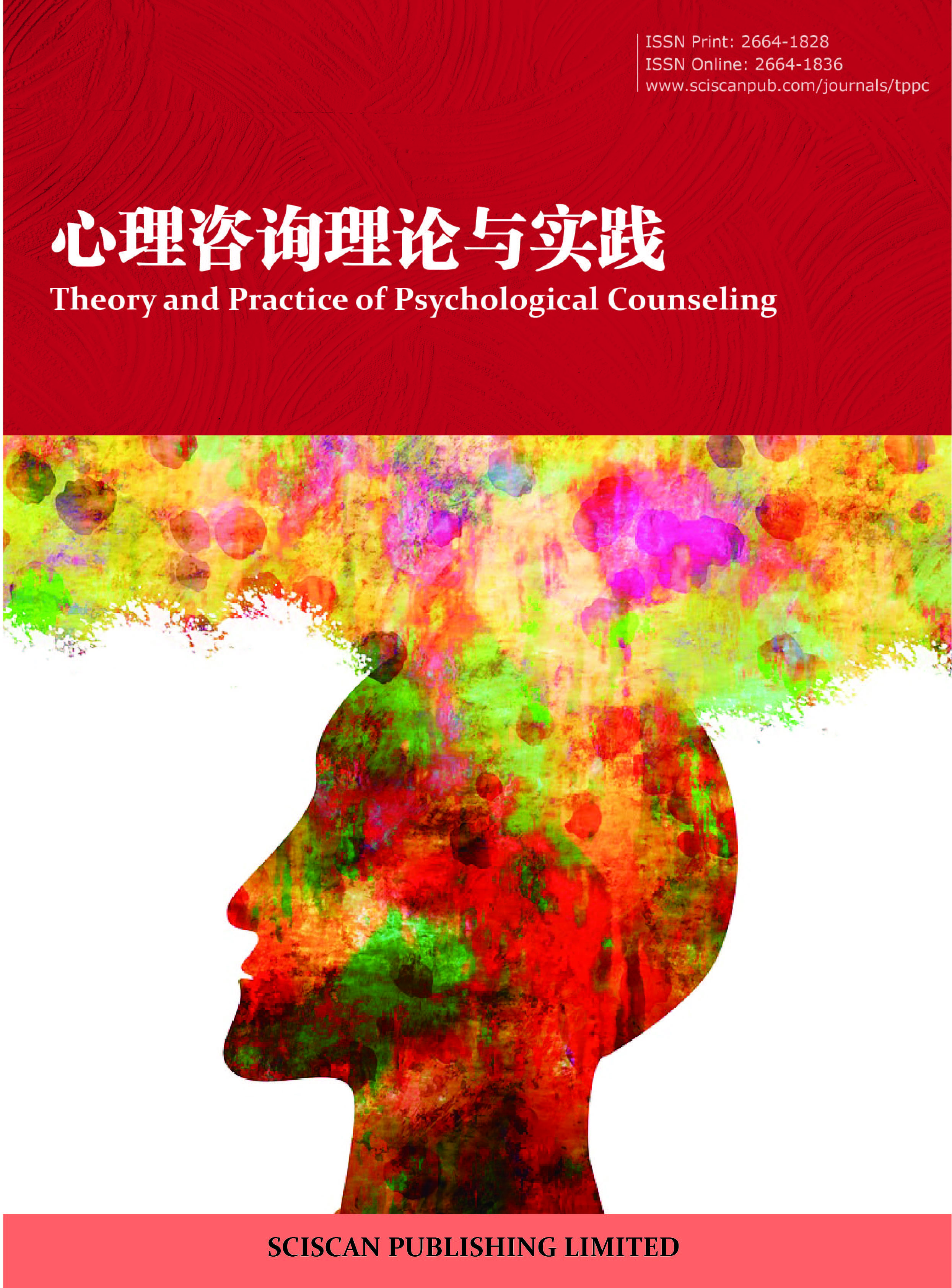Theory and Practice of Psychological Counseling
认知行为疗法对一例女性大学生强迫症状干预的个案报告
Cognitive Behavior Therapy for Obsessive-Compulsive Symptoms: A Case Study of a Female College Student
- Authors: 吕文宇
-
Information:
湖南农业大学,长沙
-
Keywords:
Cognitive Behavioral Therapy; Obsessive-compulsive symptoms; Exposure and Response Prevention (ERP); Case study认知行为疗法; 强迫症状; 暴露与反应阻止技术(ERP); 个案报告
- Abstract: This study applied Cognitive Behavioral Therapy (CBT) to intervene in a female college student with obsessive-compulsive symptoms, adopting an intervention program that combined Exposure and Response Prevention (ERP) with cognitive intervention techniques. The Yale-Brown Obsessive- Compulsive Scale (Y-BOCS) and the client’s subjective evaluation were used to assess the obsessivecompulsive symptoms. The results showed that the frequency and severity of obsessions and compulsions decreased, the client’s emotional experience improved, and her social function was enhanced. Specifically, the Y-BOCS score decreased from 24 (before consultation) to 18; the client’s degree of belief in her core belief decreased from 50 to 30; subjective assessment indicated a 40% reduction in anxiety, and a 30% reduction in the overall impact of symptoms. Additionally, the interference of symptoms on the client’s daily life was significantly reduced. 本研究应用认知行为疗法对一例女性大学生的强迫症状开展了5个阶段、共17次的干预,采用暴露与行为阻止技术和认知干预技术结合的干预方案。通过耶鲁—布朗强迫量表(Y-BOCS)及来访者主观评价对强迫症状进行评估,结果显示:来访者强迫思维与强迫行为频率下降、严重程度减弱,情绪体验得到改善,社会功能有所提升。具体数据为:Y-BOCS得分从咨询前的24分降至18分,来访者对核心信念相信程度从50分降至30分,主观评估焦虑程度下降40%,症状总体影响程度下降30%,症状对来访者日常生活的干扰显著减少。
- DOI: https://doi.org/10.35534/tppc.0708057
- Cite: 吕文宇. (2025). 认知行为疗法对一例女性大学生强迫症状干预的个案报告. 心理咨询理论与实践, 7(8), 508-517.
1 研究背景
1.1 强迫症及其症状
强迫症以强迫思维和(或)强迫行为为主要症状表现。强迫思维具有重复产生、持久存在的特点,且并非个体自发产生和非必要存在,会给个体带来明显的焦虑或痛苦感受。同时,强迫思维会促使个体产生消除或解决它的意愿,例如直接尝试忽略、压抑,或是通过精神活动、实际行为等方式进行对抗(如采用某种强迫行为来中和)。强迫行为的目的是降低、缓解强迫思维引发的焦虑或痛苦,或是预防某些灾难性事件的发生,但强迫行为与上述目的之间缺乏现实、合理的联系,或在程度上明显超出了合理范围(American Psychiatric Association & DSM-5 Task Force,2013)。按内容分类,强迫思维包括对称性强迫思维、担心被污染的强迫思维、追求整齐精确的强迫思维等;强迫行为包括强迫检查、强迫清洁、强迫整理等(Grant et al.,2014)。
强迫思维属于侵入性思维。事实上,大多数人都曾有过偶尔出现不必要想法或想象的经历,且可以忽略这些想法使其不产生负面影响。但强迫思维的特点在于,它会引发个体的直接对抗——这也是区分强迫思维与其他持续性、消极性不必要想法(抑郁反刍或焦虑相关想法)的重要标准(Harsányi et al.,2014)。
1.2 强迫症状的认知行为干预
在对强迫症状的心理干预领域,目前以认知行为疗法的应用最为广泛。认知行为疗法具有结构化、短程的特点,该疗法不过多关注来访者的过往经历,而是通过改变来访者功能不良的想法和行为,解决他们当前存在的问题(Beck,1964)。其中,认知行为疗法中侧重行为干预的暴露与反应阻止技术(ERP),被视为针对污染相关强迫症的“金标准”干预指导方法。该技术指导个体直面引发恐惧的强迫思维,并阻止个体因冲动而做出典型的强迫行为(Mathes et al.,2020)。一项包含6项ERP对强迫症疗效的研究显示,强迫症患者在不同阶段的耶鲁—布朗强迫症状问卷平均得分如下:干预前23.5分,干预后11.9分,随访时13.0分(Öst et al.,2015)。国际临床实践指南也明确建议,单独使用ERP,或联合使用认知干预技术,作为强迫症的一线心理治疗方法(Koran et al.,2007)。
1.3 强迫症的认知行为模型
参考认知行为视角下理解强迫症心理机制的相关资料,结合认知行为疗法理论与咨询实践进行调整,构建强迫症认知行为模型图(Foa & McLean,2016;Ojalehto et al.,2020;徐慊 等2018)。如图1所示,强迫思维可分为闯入性思维和灾难化想法两部分:闯入性思维即是个体在诱发情境下产生的自动思维,而灾难化想法的形成源于核心信念,与中间信念的作用机制类似。对闯入性思维做出威胁性解释和评价,是强迫症发生机制的首要环节(徐慊 等,2018)。强迫症个体往往会认为相对安全的事件存在高风险概率,并高估事件的代价或后果(Foa & McLean,2016)。事实上,强迫思维可以看作为不合理信念,这类信念会使个体产生焦虑、不适等负面感受,促使个体做出相应的强迫行为。从短期效果来看,强迫行为可以暂时缓解个体的焦虑与不适感;而从长期发展来看,这种缓解作用会对强迫行为形成负强化,导致强迫症状愈发持久、稳固。

图 1 强迫症的认知行为模型
Figure 1 Cognitive behavioral model of obsessive-compulsive disorder
结合强迫症的认知行为模型,使用认知行为疗法干预强迫症状的思路也更加清晰:认知行为疗法中的基础认知干预技术,更偏向于对认知层面(即自动思维—中间信念—核心信念)的干预,本质上是针对强迫思维的干预方法;而暴露与反应阻止技术(ERP)则更聚焦于强迫行为以及促使个体产生强迫行为的焦虑和不适感,同时该技术实施过程中的现实检验环节,也对个体修正不合理信念有所帮助。
2 个案情况
2.1 基本信息及来访原因
来访者小C为女性,25岁,药学专业大四学生。小C目前有一名交往对象(系其第一任男友),与她在一起5年,是在高中补习班认识的,存在性生活。小C的家庭结构为:父亲、母亲、弟弟(比小C小1岁)及本人。其中,母亲在砖厂工作,父亲在煤矿工作。
令小C困扰的主要问题是她的“洁癖”:如果小C接触到自认为是“脏”的物品,就需要反复洗手,或用消毒湿巾擦拭、酒精喷洒,如果不清洁,就会持续产生清洁的冲动,伴随强烈的“脏污感”。这样的情况每日会出现多次,已经对其正常学习、生活造成一定的干扰。
2.2 症状评估
在评估会谈前,小C填写了症状自评量表(SCL-90)与耶鲁—布朗强迫量表(Y-BOCS)。其中,小C在SCL-90强迫症状分量表得分为26分,提示存在强迫症状,其他分量表得分未见明显异常。使用耶鲁-布朗强迫量表(Y-BOCS),对小C的强迫症状严重程度和具体情况进行评估。结果显示:小C在强迫思维维度得分为11分,强迫行为维度得分为13分,量表总分为24分,符合中度强迫症状的判定标准。
结合会谈信息及量表结果,小C存在明显的强迫症状,具体表现为“担心被污染致病”的强迫思维,以及“反复清洁”的强迫行为,该症状已经持续两年以上。小C对到精神科就医诊断存在抵触情绪,故目前暂无未有明确的临床诊断结果。
2.3 个案概念化
2.3.1 横向分析
对小C的个案概念化横向分析,主要是通过梳理其当前生活中诱发强迫症状的情境、伴随感受及应对方式,明确强迫症状的发生机制及维持原因。使用OCD行为功能分析表对小C的强迫症状展开分析,如表1所示。
小C惯常使用的防御机制为回避和抵消,当她使用这样的防御机制应对自认为“危险”的情境时,也就容易产生强迫行为,焦虑感的暂时缓解,会对强迫行为形成持续负强化,从而导致强迫症状出现和逐步发展。
表1 小C的OCD行为功能分析表
Table 1 OCD behavioral function analysis of C
|
诱发情境 |
闯入思维 |
对闯入性思维的评价或预期 |
情绪/生理反应(0~100分) |
强迫行为 |
强迫行为后的情绪/生理反应(0~100分) |
|
第一类线索 (举例): 上公共厕所 |
我可能接触到了别人的生殖器分泌物,他们可能有性病 |
我可能会被传染上性病;性病难以治愈,而且治疗过程很痛苦 |
焦虑:100分 害怕:100分 |
(1)尽可能地不碰到公共厕所内的物品 (2)上完厕所后用杀菌洗手液洗手 |
焦虑:30分 害怕:30分 |
|
第二类线索 (举例): 同学碰了的她刚洗过的床单 |
同学没有洗手,我的床单弄脏了,会有细菌和病毒 |
我的床单必须要保持干净;我躺上去会接触到细菌和病毒,我可能会生病 |
焦虑:80分 无奈:60分 |
(1)重新清洗床单,再次亲手洗 (2)会和比较熟悉的同学说明不希望他们碰到她的物品 |
焦虑:20分 无奈:40分 疲劳:60分 |
|
第三类线索 (举例): 碰到了妈妈用的杯子 |
杯子是脏的,妈妈之前可能碰过垃圾筐和其他脏东西 |
我应该去洗手;我可能接触到细菌和病毒 |
焦虑:60分 害怕:60分 |
(1)用杀菌洗手液洗手 (2)尽量不去碰其他家人用的物品 |
焦虑:10分 害怕:10分 |
2.3.2 纵向分析
对小C的个案概念化纵向分析,主要聚焦于其不合理信念及强迫行为:从个人经历中挖掘二者的起源、维持过程相关的重要事件和诱发因素,并结合小C的防御机制、人格特征展开分析。小C的信念系统如图2所示。

图2 小C的信念系统
Figure 2 Belief system of C
小C的核心信念是“世界是不安全的”,与之密切关联的人格特征便是其过低的安全感。除与强迫症状直接相关的“对生病感到害怕”外,“不敢一个人睡觉”“晚上八点后不外出”等表现,都能体现出她的低安全感。
3 咨询过程
3.1 信息收集阶段(第1-4次)
在这个阶段中,咨询的主要目的是了解小C的个人信息,同时建立良好的咨访关系,促进咨询的顺利推进。
小C将自己当前的症状描述为“洁癖”,具体表现为碰了“感觉是脏的”的物品后反复洗手;对于自用物品若是感觉脏了,则用湿巾擦拭、酒精消毒等;若不清洁则会持续产生清洁的冲动,觉得伴随强烈的“脏污感”,这样的情况在一天中会出现多次。小C的这种强迫清洁行为是从大二学年开始的,在这个阶段发生了三件事情:(1)一门课上,教师讲了一个“一家人住宾馆,而后全家人(含儿童)都患上性病”的案例——小C认为儿童是“最不可能接触性病”的群体,所以对这个案例印象深刻,同时教师说要注意公共物品卫生;(2)和男朋友有了第一次性经历时,因为未注意卫生防护,导致感染霉菌引发妇科炎症,后续的样本采集与用药也伴随着不适与不便;(3)看到保洁阿姨在用拖把擦完公厕内部后,又直接拿来擦拭厕所门。
在这之后小C逐渐出现过度且无法控制的清洁行为:格外担心公共场所与设施的卫生情况,认为会有大量细菌和病毒。具体表现为:上课前用含酒精的湿巾擦拭消毒课桌和椅子;即使在夏天,因为不希望皮肤外露,会选择长袖和长裤;若是他人接触过自己的床单、被罩,就会全部重新清洗一遍。更普遍的症状是——手部、头发等外露身体部位在接触自己物品以外的东西后,都会有反复洗手或用酒精消毒等强迫清洁行为。但小C对自己的症状有良好的自知力,认为“清洁行为过度”,并且有强烈的改变意愿。她提出的理想状态是“对疾病的担心还是要需保持,但应做到正确预防、合理预防”,核心咨询目标是“不用再通过繁琐的清洁行为缓解焦虑”。
3.2 不合理信念的发现与干预阶段(第5-8次)
在这个阶段中,咨询的主要目的是识别小C存在的不合理信念,并开展认知重建工作。
“害怕”是小C在日常生活中经常体验的感受,“容易害怕、安全感低”是明显的特点,她也认为自己“害怕的东西是比较多的”。与之相对应,小C的焦虑情绪中占主体的也是“害怕”,她会常用“害怕生病”来描述自己的焦虑状态。由于“回忆和想象情境”的干预方法效果未达预期,咨询师与小C商议后,决定先开展一次低等级暴露尝试,通过重现情境,帮助她重新体验当时的感受与梳理潜在信念。在暴露尝试前,咨询师向小C说明了强迫行为的产生机制与干预原理。
在使用的认知干预技术中,小C接受程度较高、干预效果较好的是“证据法”。首次使用证据法干预不合理信念,虽然使用后小C的清洁冲动下降幅度有限,但她初步了解与体会到:除强迫行为外,还存在应对强迫思维、缓解焦虑与不适感的新方法。咨询师也由此为小C布置了家庭作业:要求她在咨询外的生活中,若遇到“觉得脏”的情境,尝试用证据法与不合理信念进行辩驳,以更加理性的视角看待自己的思维与所处的情境;同时,在焦虑状态尽量延长耐受时间,并通过思维改变记录表记录1至2次干预过程,记录内容需包含干预前后对自动思维的相信程度(如表2所示)。
表 2 小C的第一个思维改变记录表
Table 2 The first thinking change record of C
|
发生事件 |
自动思维 |
对思维的相信程度(1~100) |
支持的证据 |
反对的证据 |
思考、辩驳后的相信程度(1~100) |
之后的做法和感受 |
|
碰到了爸爸的手机 |
手机是脏的,应该去洗手 |
80 |
(1)手会经常接触手机 (2)爸爸基本上不会擦手机 (3)手机掉地上也不会擦 (4)有时手机会直接放地上充电 |
(1)空气中、身体中也会有细菌,并且人体自身有免疫力,所以应该不会生病的 (2)经常洗手会比较麻烦,希望不要频繁洗手 |
70 |
坚持没有洗手的时间会长一点,但是后面就觉得算了还是去洗吧,一直想着也麻烦的,直接洗了就不会想了 |
|
鞋子不小心碰到了公共厕所的门 |
公共厕所细菌太多了,应该洗一下鞋子 |
90 |
(1)公共厕所去的人很多,所以细菌也会比较多 (2)景区的人比较杂,所以有可能会有一些致病菌 (3)打扫的工作人员打扫得不全面、不到位 |
(1)空气中、身体中也会有细菌,并且人体自身有免疫力,所以应该不会生病的 (2)鞋子就穿了一天,特别不想洗了 (3)觉得应该用消毒湿巾擦一下也可以的 |
70 |
因为当时是在景区,所以没有及时处理,坚持的时间还是挺长的,但是心里一直想着这个事情,回到家里用消毒湿巾擦了两遍,还是有一点不放心 |
该阶段中,小C与咨询师共同探索并明确了她的不合理信念(主要涉及自动思维与中间信念),她学会了应对强迫思维的新方法,并能够在生活中自主使用,展现出了一定的干预效果。但仍然存在以下问题:1.干预前后,小C对自动思维的相信程度下降幅度较小,维持在10~20分区间;2.干预可以延长“强迫思维出现到实施强迫行为”的间隔时间,但并没有阻止强迫行为的发生;3.小C的强迫清洁行为仍存在反复、多次发生的情况。
3.3 暴露与反应阻止技术阶段(第9-16次)
在这个阶段中,咨询师应用暴露与反应阻止技术(ERP)对小C的强迫症状展开干预。咨询主要围绕“小C强迫症状的诱发线索”设计暴露训练,咨询师与小C共同确认的暴露等级表如表3所示。
表 3 小C的暴露等级表
Table 3 Exposure levels of C
|
等级 |
诱发线索(情境、物品) |
SUDs得分(0~100) |
回避程度(0~100) |
|
1 |
公共厕所 |
100 |
100 |
|
2 |
地面 |
95 |
100 |
|
3 |
垃圾筐 |
90 |
100 |
|
4 |
在外面玩的毽子、羽毛球 |
85 |
90 |
|
5 |
几个家人都用过的杯子 |
85 |
90 |
|
6 |
烟灰缸 |
80 |
80 |
|
7 |
弟弟的杯子 |
70 |
80 |
|
8 |
弟弟更常用的眼镜盒 |
60 |
70 |
|
9 |
妈妈、弟弟试过的防晒袖套 |
50 |
70 |
|
10 |
弟弟的眼镜盒 |
40 |
60 |
注:SUDs(Subjective Units of Distress Scale)指来访者因诱发线索产生的主观困扰程度;回避程度指来访者通过回避的方式应对该主观困扰的程度;等级1~10依据SUDs分值从高到低排列。
咨询师向小C介绍了暴露与反应阻止技术(ERP)的基本原理:小C许按照“主观困扰程度从低到高”的顺序,逐步面对引发不适感受的诱发线索,开展逐级暴露训练;过程中需要保持在焦虑状态中,感受焦虑、不适感的自然消退,同时将暴露训练的结果与自身预想结果进行对比,验证“担心的糟糕结果是否真的会发生”。此外,无论是在咨询中的暴露训练环节,还是在生活中面对“想要清洁”的情境,小C都可以继续使用证据法干预强迫思维,以降低灾难化想法的强度。
暴露训练均采用“与强迫思维干预相结合”的方式。咨询师与小C讨论感受后发现:在接触诱发线索后,若能立即识别当前的自动思维,并采用证据法进行干预,可以有效降低她当前的焦虑感——而此时她也正处在焦虑感的峰值阶段。这意味着,通过识别并干预不合理信念,有助于降低小C因强迫思维引发的焦虑峰值,焦虑峰值示意图如图3所示。

图3 暴露后识别并干预不合理信念降低小C的焦虑峰值示意图
Figure 3 Peak of anxiety of C reduced by identifying and intervening irrational beliefs
同时,在小C多次识别“引发焦虑和后续强迫行为的不合理信念”的过程中,她对自己的灾难化想法的描述也逐渐变得更加具体。在第11、12次咨询中,咨询师使用“向下箭头法”帮助小C进一步梳理灾难化想法,最终引出了“世界是不安全的”的核心信念。经过讨论,小C发现“空气中也有细菌,但自己每天接触并无异常”这一信念,对她“接触‘脏东西’、面对‘不安全的世界’”有所帮助,能减少部分担忧。
本阶段中,小C完成了基于ERP技术的逐级暴露训练,由于部分诱发情境难以在咨询场景中实施暴露,该部分等级情境的暴露和练习,主要结合小C的家庭作业开展,如表4所示。
表4 小C的第七个思维改变记录表
Table 4 The seventh thinking change record of C
|
发生事件 |
自动思维 |
对思维的相信程度(1~100) |
支持的证据 |
反对的证据 |
思考、辩驳后的相信程度 (1~100) |
之后的做法和感受 |
|
我弟把刷鞋的水弄我手上了 |
那个水挺脏的,想洗手 |
85 |
(1)鞋子每天在地上踩着会比较脏一些 (2)穿着鞋子去过很多公共的场所,如公共厕所 |
(1)刷鞋的时候刷的是鞋面,所以细菌应该不是特别多 (2)只是弄了一小滴水 (3)细菌在鞋子上面不一定能存活 |
70 |
当时先清洁了一下,过了一会,想到我去过公共厕所就又清洁了一次,才放心了一些 |
|
别人碰了公共厕所的门,然后又拿了我的手机 |
想先擦一下手机,再拿着它 |
95 |
(1)公共厕所的门每天会有很多不同的人接触 (2)打扫卫生的阿姨也会碰到门 (3)公共厕所并没有进行真正干净的清洁,也没有消毒 |
(1)每天都有很多人接触那个门,但是很少有人是接触这个生病的 (2)自身有一定的免疫力,即使接触了细菌也不一定会生病的 (3)细菌在门上面并不能存活很长时间 |
80 |
那天是在外面的,清洁条件有限,当时就没有清洁,坚持的时间挺长的,直到回去之后才拿酒精消毒湿巾擦了手机和手 |
经过多次逐级暴露训练,小C对“接触‘脏的东西’”的适应度显著提升,每次暴露训练后,清洁冲动也都有不同程度下降。同时,小C逐渐形成了一些新的、更加理性的信念,如“如果总不接触脏东西,自己的免疫力也会下降”“自己好像从大二开始一直处于过度担忧的状态,可能也不需要那么担心”等。小C反馈,强迫症状对生活的困扰已经明显减少,不那么“麻烦”,在她看来,自己最希望达成的咨询目标已经基本实现。
3.4 结束阶段及效果评估(第17次)
本阶段中,咨询师与小C共同回顾整个咨询过程,评估小C各方面的改善情况,复习她此前学过的“应对强迫症状的经验和方法”,并在此基础上对未来生活进行展望。
小C提到,本周自主尝试了一次“接触‘脏东西’后完全不清洁”——这既是一次更高强度的暴露与行为阻止训练,也是又一次新的现实检验。本次她成功坚持未进行清洁,且依然是没有发生任何担忧的负面结果,这让她对“面对之前觉得‘脏’的东西”更有信心。
数据显示,小C的耶鲁-布朗强迫量表(Y-BOCS)总分从24分降至18分;同时,咨询师邀请小C进行了主观评估,结果如下:(1)对“世界是不安全的”这一核心信念的相信程度从50分降至30分;(2)认为强迫症状对日常生活的干扰程度整体下降30%;(3)面对“脏东西”时的焦虑、不适感整体下降40%;(4)清洁冲动也有整体减轻。
小C认为,通过咨询,自己的“洁癖”已明显减轻了,特别是在日常生活中,不再像之前那么苦恼;她不仅学会了应对强迫症状的方法,也明显“更多的时候还是需要自己主动实践”,同时对未来面对相关问题充满信心。她最后提到,在咨询过程中印象最深刻的是咨询师的耐心,这也是让她感觉最温暖的一点。
4 总结与讨论
总体而言,小C经过17次咨询后,强迫症状得到比较明显的改善,且在强迫思维和强迫行为两方面均有体现:症状对其日常生活的干扰显著降低,因症状产生的焦虑、不适感也显著减轻;在咨询目标达成方面,已达到了小C自己相对满意的程度。
除重视理论模型的应用外,本次咨询实践中还有两点启示值得关注:第一,咨询过程需贴近来访者的实际经验,本案例中,每一步咨询进程都是由咨询师与小C共同商议确定,充分尊重了小C的意愿,确保咨询以小C能够适应的步调推进,结合小C的成长经历可以发现,咨询师的耐心令她体会到了成长经历中很少能感受到的支持与稳定感,这种耐心也成为她重建安全感、干预核心信念的关键因素。第二,需重视咨询外的实践时间,来访者会在两次咨询间隔期间进一步开展现实检验,观察实际发生的事件是否符合自己先前的预期,通过真实的反馈,进一步巩固新形成的经验和信念。为了帮助来访者在咨询外运用新经验,咨询师首先需提供支持与动力,清楚解释实践的意义和价值,令来访者“能做、愿意做”;其次需构建、维护良好的咨访关系,确保来访者对咨询师足够信任与主动配合。
参考文献
[1] 徐慊, 朱雅雯, 余萌, 王建平. (2018). 强迫障碍的认知行为个案概念化咨询个案报告. 中国心理卫生杂志, 32(3), 207-214.
[2] American Psychiatric Association, & DSM-5 Task Force. (2013). Diagnostic and statistical manual of mental disorders: DSM-5™ (5th ed.). Arlington: American Psychiatric Publishing Inc.
[3] Beck, A. T. (1964). Thinking and depression: II. theory and therapy. Archives of General Psychiatry, 10(6), 561-571.
[4] Foa, E. B., & McLean, C. P. (2016). The efficacy of exposure therapy for anxiety-related disorders and its underlying mechanisms: The case of OCD and PTSD. Annual Review of Clinical Psychology, 12(1), 1-28.
[5] Grant, J. E., Odlaug, B. L., & Schreiber, L. R. N. (2014). Pharmacotherapy for obsessive-compulsive and related disorders among adults. In E. A. Storch & D. McKay (Eds.), Obsessive-compulsive disorder and its spectrum: A life-span approach (pp. 317-343). American Psychological Association.
[6] Harsányi, A., Csigó, K., Rajkai, C., Demeter, G., Németh, A., & Racsmány, M. (2014). Two types of impairments in OCD: Obsessions, as problems of thought suppression; compulsions, as behavioral-executive impairment. Psychiatry Research, 215(3), 651-658.
[7] Koran, L. M., Hanna, G. L., Hollander, E., Nestadt, G., Simpson, H. B., & American Psychiatric Association. (2007). Practice guideline for the treatment of patients with obsessive-compulsive disorder. The American Journal of Psychiatry, 164(7 Suppl), 5-53.
[8] Mathes, B. M., Day, T. N., Wilver, N. L., Redden, S. A., & Cougle, J. R. (2020). Indices of change in exposure and response prevention for contamination-based OCD. Behaviour Research and Therapy, 133, Article 103707.
[9] Ojalehto, H. J., Abramowitz, J. S., Hellberg, S. N., Buchholz, J. L., & Twohig, M. P. (2020). Adherence to exposure and response prevention as a predictor of improvement in obsessive-compulsive symptom dimensions. Journal of Anxiety Disorders, 72, Article 102210.
[10] Öst, L. G., Havnen, A., Hansen, B., & Kvale, G. (2015). Cognitive behavioral treatments of obsessive-compulsive disorder: A systematic review and meta-analysis of studies published 1993-2014. Clinical Psychology Review, 40, 156-169.
















